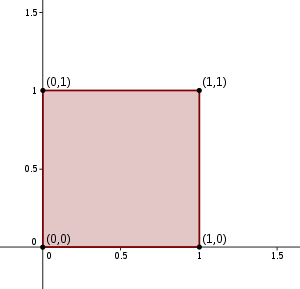Unit square

In mathematics, a unit square is a square whose sides have length 1. Often, "the" unit square refers specifically to the square in the Cartesian plane with corners at the four points (0, 0), (1, 0), (0, 1), and (1, 1).
Cartesian coordinates
In a Cartesian coordinate system with coordinates (x, y) the unit square is defined as the square consisting of the points where both x and y lie in a closed unit interval from 0 to 1.
That is, the unit square is the Cartesian product I × I, where I denotes the closed unit interval.
Complex coordinates
The unit square can also be thought of as a subset of the complex plane, the topological space formed by the complex numbers. In this view, the four corners of the unit square are at the four complex numbers 0, 1, i, and 1 + i.
Rational distance problem
| | Unsolved problem in mathematics: Is there a point in the plane at a rational distance from all four corners of a unit square? (more unsolved problems in mathematics) |
It is not known whether any point in the plane is a rational distance from all four vertices of the unit square.[1] However, no such point is on an edge of the square.[2]
See also
References
- ↑ Guy, Richard K. (1991), Unsolved Problems in Number Theory, Vol. 1 (2nd ed.), Springer-Verlag, pp. 181–185.
- ↑ Barbara, Roy (March 2011), "The rational distance problem", Mathematical Gazette, 95 (532): 59–61.